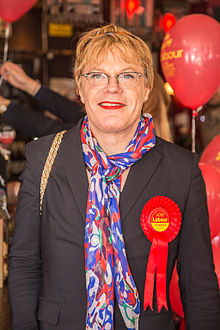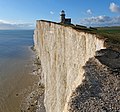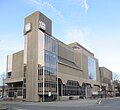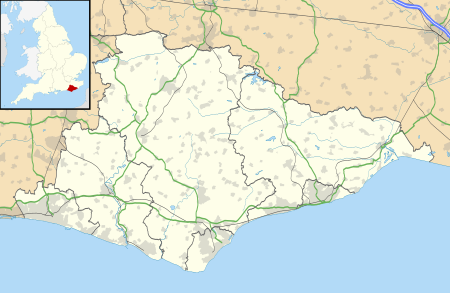Portal:East Sussex

East Sussex is a ceremonial county in South East England. It is bordered by Kent to the north-east, West Sussex to the west, Surrey to the north-west, and the English Channel to the south. The largest settlement is the city of Brighton and Hove, and the county town is Lewes.
The county has an area of 1,792 km2 (692 sq mi) and a population of 822,947. The latter is largely concentrated along the coast, where the largest settlements are located: Brighton and Hove (277,105), Eastbourne (99,180), and Hastings (91,490). The centre and north of the county are largely rural, and the largest settlement is Crowborough (21,990). For local government purposes, East Sussex comprises a non-metropolitan county, with five districts, and the unitary authority of Brighton and Hove. East Sussex and West Sussex historically formed a single county, Sussex.
East Sussex is part of the historic county of Sussex, which has its roots in the ancient kingdom of the South Saxons, who established themselves there in the 5th century AD, after the departure of the Romans. Archaeological remains are plentiful, especially in the upland areas. The area's position on the coast has also meant that there were many invaders, including the Romans and later the Normans, following the defeat of the English army by William the Conquerer at the Battle of Hastings in 1066. Earlier industries included fishing, iron-making, and the wool trade, all of which have declined or been lost completely. (Full article...)
Selected article

Brighton (/ˈbraɪtən/ BRY-tən) is a seaside resort and one of the two main areas of the city of Brighton and Hove in the county of East Sussex, England. It is located 47 miles (76 km) south of London. Archaeological evidence of settlement in the area dates back to the Bronze Age, Roman and Anglo-Saxon periods. The ancient settlement of "Brighthelmstone" was documented in the Domesday Book (1086). The town's importance grew in the Middle Ages as the Old Town developed, but it languished in the early modern period, affected by foreign attacks, storms, a suffering economy and a declining population. Brighton began to attract more visitors following improved road transport to London and becoming a boarding point for boats travelling to France. The town also developed in popularity as a health resort for sea bathing as a purported cure for illnesses.
In the Georgian era, Brighton developed as a highly fashionable seaside resort, encouraged by the patronage of the Prince Regent, later King George IV, who spent much time in the town and constructed the Royal Pavilion in the Regency era. Brighton continued to grow as a major centre of tourism following the arrival of the railways in 1841, becoming a popular destination for day-trippers from London. Many of the major attractions were built in the Victorian era, including the Grand Hotel, the Hilton Brighton Metropole, the Palace Pier and the West Pier. The town continued to grow into the 20th century, expanding to incorporate more areas into the town's boundaries before joining Hove to form the unitary authority of Brighton and Hove in 1997, which was granted city status in 2000. Today, Brighton and Hove district has a resident population of about 277,965 and the wider Brighton and Hove conurbation has a population of 474,485 (2011 census).
Brighton's location has made it a popular destination for tourists, renowned for its diverse communities, shopping areas, large and vibrant cultural, music and arts scene, and its large LGBT population, leading to its recognition as the "unofficial gay capital of the UK" and as of the 2021 census, 10.7% of the population of Brighton and Hove over the age of 18 identify as gay, lesbian or bisexual, the highest percentage in the entire UK. Brighton has been called the UK's "hippest city" and "the happiest place to live in the UK". (Full article...)
Selected images
Selected biography
Eddie Izzard (/ˈɪzɑːrd/; born Edward John Izzard; 7 February 1962), also known as Suzy Izzard, is a British stand-up comedian, actor, and activist. Her comedic style takes the form of what appears to the audience as rambling whimsical monologues and self-referential pantomime.
Izzard's stand-up comedy tours have included Live at the Ambassadors (1993), Definite Article (1996), Glorious (1997), Dress to Kill (1998), Circle (2000), Stripped (2009), Force Majeure (2013) and Wunderbar (2022). She starred in the television series The Riches (2007–2008), and has appeared in numerous films, including Ocean's Twelve (2004), Ocean's Thirteen (2007), Valkyrie (2008), Absolutely Anything (2015) and Six Minutes to Midnight (2020). Izzard has also worked as a voice actor on films such as Five Children and It (2004), The Wild (2006), The Lego Batman Movie (2017) and the Netflix original series Green Eggs and Ham (2019). Among various accolades, she won two Primetime Emmys for Dress to Kill and was nominated for a Tony Award for her Broadway performance in A Day in the Death of Joe Egg.
In 2009, Izzard completed 43 marathons in 51 days for Sport Relief, despite having no history of long-distance running. In 2016, she ran 27 marathons in 27 days in South Africa in honour of Nelson Mandela, raising £1.35 million. In addition to her native English, she regularly performs stand-up in Arabic, French, German, Russian, and Spanish, and is an active supporter of Europeanism and the European Union.
A dedicated Labour Party activist, Izzard twice ran unsuccessfully for the party's National Executive Committee and then joined as the most successful initially non-elected person after Christine Shawcroft resigned in March 2018. In 2022, Izzard attempted to become the party's prospective parliamentary candidate for Sheffield Central but was not selected in the members' ballot. In 2023, Izzard attempted to become the party's prospective parliamentary candidate for Brighton Pavilion but was not selected in the members' ballot. (Full article...)
Did you know that

Long Man of Wilmington is 227 feet (69 metres) tall and designed to look proportional when viewed from below
General images -
List articles

- List of hills of East Sussex
- List of local nature reserves in East Sussex
- List of monastic houses in East Sussex
- List of museums in East Sussex
- List of Parliamentary constituencies in East Sussex
- List of places in East Sussex
- List of settlements in East Sussex by population
- List of Sites of Special Scientific Interest in East Sussex
- List of windmills in East Sussex
Subcategories
Settlements map
Things you can do
- Add to this portal.
- Join the Sussex WikiProject
Topics
Related portals
Associated Wikimedia
The following Wikimedia Foundation sister projects provide more on this subject:
-
Commons
Free media repository -
Wikibooks
Free textbooks and manuals -
Wikidata
Free knowledge base -
Wikinews
Free-content news -
Wikiquote
Collection of quotations -
Wikisource
Free-content library -
Wikiversity
Free learning tools -
Wikivoyage
Free travel guide -
Wiktionary
Dictionary and thesaurus
























































































